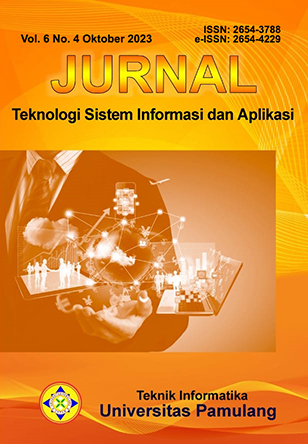Perancangan Sistem Informasi Akuntansi Pengeluaran Kas pada Balai Besar Standardisasi dan Pelayanan Jasa Industri Selulosa Bandung dengan Metode Waterfall
Keywords:
Cash Expenditure, Design, Information System, Microsoft Visual Studio, Waterfall.Abstract
Through this research, it can be seen that the Center for Standardization and Services of the Cellulose Industry uses the SAKTI application in processing cash expenditure data. The SAKTI application itself was made by the Directorate General of Treasury where the application is used by all accounting entities and reporting entities of State Ministries or Institutions including the Center for Standardization and Cellulose Industry Services. This causes problems slowing down access to the SAKTI application due to the large number of entities using the SAKTI application at the same time. Therefore, a companion system planning is made in addition to the main system that is already running with the aim of making it easier for the expenditure treasurer to process cash expenditure transactions when the main system is experiencing problems. The methods used in the study include qualitative methods with descriptive characteristics. The data collection methods used include conducting observations, direct interviews and conducting literature reviews. Research design techniques using waterfall method with Microsoft Visual Studio software. The design of the cash disbursement system created can help the finance department in processing cash expenditure transactions easily, quickly and accurately.
References
Abdurahman, M., Thalib, A., & Ambarita, A. (2019). Sistem Informasi Akuntansi Arus Kas pada Kantor Desa Bobaneigo Kec. Kao Teluk Kabupaten Halmahera Utara. Indonesian Journal On Information Systems, 4(2), 78-86, https://doi,org/10.36549/ijis.v4i2.56.
Anna, Nurmalasari, & Yusnita, A. E. (2018). Rancang Bangun Sistem Informasi Akuntansi Penerimaan dan Pengeluaran Kas pada Kantor Camat Pontianak Timur. Jurnal Khatulistiwa Informatika, 1(2), 107-118. https://doi.org/10.31294/jki.v6i2.5727.
Budiman, K. (2022). Buku Ajar Rekayasa Perangkat Lunak. Jawa Tengah. Pustaka Rumah C1nta.
Daniawati, D., Aditiarno, R., & Suharto, E. (2023). Perancangan Sistem Informasi Akuntansi Kas Kecil Berbasis Web di Politeknik Piksi Ganesha. Management Studies and Entrepreneurship Journal, 4(4), 4070-4079. https://doi.org/10.37385/msej.v4i5.2606.
Haryono, C. G. (2020). Ragam Metode Penelitian Kualitatif Komunikasi. Jawa Barat. CV Jejak, anggota IKAPI.
Ibrahim, A. (2021). Metodologi Penelitian Ekonomi dan Bisnis Islam. Aceh. PT. Naskah Aceh Nusantara.
Kementerian Keuangan. (2021). Peraturan Menteri Keuangan tentang Pelaksanaan Sistem Sakti. https://peraturan.bpk.go.id/Home/Detail/187698/pmk-no-171pmk052021.
Khairani, D. (2022). Manajemen Proyek dalam Rekayasa Perangkat Lunak (RPL). Yogyakarta. CV. Budi Utama.
Lumabi, A. I. D., Runtu, T., & Datu, C. (2022). Analisis Sistem Informasi Akuntansi Pengeluaran Kas pada Badan Kesatuan Bangsa dan Politik Provinsi Sulawesi Utara. Jurnal LPPM Bidang EkoSosBudKum (Ekonomu, Sosial, Budaya, dan Hukum), 6(1), 1003-1012. https://ejournal.unsrat.ac.id/v3/index.php/lppmekososbudkum/article/view/44753.
Mamik. (2015). Metodologi Kualitatif. Sidoarjo. Zifatama Publisher.
Muharni, S. (2021). Analisa dan Perancangan Sistem Informasi. Yogyakarta. Bintang Pustaka Madani.
Mulyani, S. (2016). Metode Analisis dan Perancangan Sistem Ed-2. Bandung. Abdi Sistematika.
Murad, A. A., & Wahyuddin. (2022). Ekonomi Makro Suatu Analisis dan Aplikasi “Komputerâ€. Surabaya. CV. Jakad Media Publishing.
Suryati, E. (2018). Sistem Pengeluaran Kas pada Kantor Sekretariat DPRP Kabupaten Bengkalis. Jurnal Menara Ilmu, 12(80), 42-49. https://doi.org/10.33559/mi.vl2i80.642.
Tawakkal, G. T. I., & Rohman, A. Z. F. (2022). Metode Penelitian Kualitatif (Penerapan pada Kajian Politik Pemerintahan). Malang. UB Press.
Downloads
Published
How to Cite
Issue
Section
License
Copyright (c) 2023 Fitria Apriliani, Ratnanto Aditiarno, Candra Mecca Sufyana

This work is licensed under a Creative Commons Attribution-NonCommercial 4.0 International License.
Authors who publish with this journal agree to the following terms:
- Authors retain copyright and grant the journal right of first publication with the work simultaneously licensed under a Creative Commons Attribution License that allows others to share the work with an acknowledgement of the work's authorship and initial publication in this journal.
- Authors are able to enter into separate, additional contractual arrangements for the non-exclusive distribution of the journal's published version of the work (e.g., post it to an institutional repository or publish it in a book), with an acknowledgement of its initial publication in this journal.
- Authors are permitted and encouraged to post their work online (e.g., in institutional repositories or on their website) prior to and during the submission process, as it can lead to productive exchanges, as well as earlier and greater citation of published work (See The Effect of Open Access).
Jurnal Teknologi Sistem Informasi dan Aplikasi have CC BY-NC or an equivalent license as the optimal license for the publication, distribution, use, and reuse of scholarly work.
In developing strategy and setting priorities, Jurnal Teknologi Sistem Informasi dan Aplikasi recognize that free access is better than priced access, libre access is better than free access, and libre under CC BY-NC or the equivalent is better than libre under more restrictive open licenses. We should achieve what we can when we can. We should not delay achieving free in order to achieve libre, and we should not stop with free when we can achieve libre.
This work is licensed under a Creative Commons Attribution-NonCommercial 4.0 International (CC BY-NC 4.0) License
YOU ARE FREE TO:
- Share - copy and redistribute the material in any medium or format
- Adapt - remix, transform, and build upon the material for any purpose, even commercially.
- The licensor cannot revoke these freedoms as long as you follow the license terms



_2020_-_7(2)_2024_-_Thumbnail.png)












